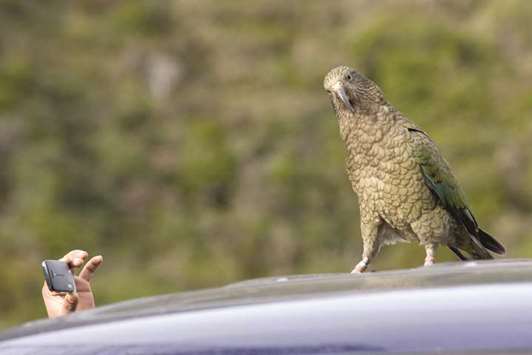They’re known to pinch anything they can get their strong beaks into. That includes wallets, passports and the odd lunch from tourists – often while they’re distracted watching the antics of the world’s only alpine parrots.
But the stolen sandwiches, bags of chips and windscreen-wiper blades aren’t the only the reason that conservationists and road management agencies have teamed up to create kea gyms.
In November 2016, labourers were left puzzled when they found road cones in odd places each time they returned to work at the remote Homer Tunnel at the entrance to Milford Sound, one of the country’s most famous tourist attractions and a Unesco World Heritage site.
When the workers checked the footage from their CCTV cameras, they saw a group of kea moving the cones. While they most likely carried them purely for their own entertainment, some experts suggested the birds purposely moved them into the lanes, forcing traffic to stop and giving the kea a chance to beg for food from tourists.
Infrastructure services company Downer, which maintains the highway, found the inquisitive birds a significant safety hazard and supported the installation of kea roadside gyms.
“The gym has been designed to keep them intellectually engaged. It’s equipped with ladders, spinning flotation devices, swings and climbing frames, which they can play with, or take apart, to distract them from danger and from causing damage,” a Downer spokeswoman said.
“We’re also monitoring the gym with cameras so researchers at the University of Canterbury can analyse their behaviour and develop new ways of interacting with the birds.”
Kea, which sport an emerald green plumage edged with black and bright orange feathers, can grow to the size of cats and are sometimes dubbed the “clowns of the mountain.”
Tamsin Orr-Walker, from the Kea Conservation Trust, said that kea are from the world’s most ancient parrot lineage, which includes the critically endangered kakapo and the kaka.
“They are highly intelligent problem-solvers which have adapted to an extremely harsh environment in the South Island of New Zealand,” Orr-Walker said.
Although kea are not known to “talk” like some other parrots, they are considered as smart as a 4-year-old child and similar to primates in terms of their intelligence.
With an estimated 5,000 kea remaining in the wild, they are listed as nationally endangered, and their numbers are decreasing.
Kea were voted New Zealand’s “bird of the year” in 2017, but not everybody loves the cheeky parrot.
“At least 150,000 kea were killed in a government bounty due to conflict with high-country sheep farmers until they gained full protection in 1986,” Orr-Walker said.
Now they’re making enemies by damaging parked cars, buildings and forestry equipment as well as attacking stock and stealing food.
Kea face three main dangers today, Orr-Walker said, including introduced species such as stoats, possums and feral cats; lead poisoning from lead fixtures taken from old buildings in the backcountry; and direct contact with humans – like being hit by cars or being fed inappropriate food.
“The kea gyms are designed to draw kea away from at-risk areas such as roadways, and hopefully will reduce the likelihood of kea damaging human property by providing other areas of interest,” Orr-Walker said.
“It is also hoped that the gyms will provide an opportunity to educate people about not feeding kea and the importance of protecting our remnant kea populations,” she added.
So far, three playgrounds have been set up around New Zealand’s South Island. Orr-Walker said the results look promising, but that it is too early to tell if they will be successful in saving kea from their own curiosity.
Orr-Walker offered one last plea for anyone encountering a kea in the wild.
“If you love our cheeky mountain parrots, don’t give them a death sentence by feeding them,” she said. – DPA

FRAMED: An occupant of a car uses a mobile phone to take picture of a kea on top of a car in Arthur’s Pass in New Zealand.
